(Continued from: The Memorial Day Weekend Mega Tour - Part 2)
After stopping in at the Kelso Depot Visitor’s Center of the Mojave National Preserve and talking with the ranger, I had to devise a new plan. I wouldn’t be able to follow the Cima Subdivision’s trackage, nor camp along the route, as I had hoped to do.
I was still permitted to follow the trackage from Kelso to Cima, California via the Kelso Cima Road so, that coupled with the knowledge of a possible camp site relatively close to Cima, that the ranger told me about, gave me enough incentive to continue with my plans - albeit modified extensively.
I drove north towards Cima at a leisurely pace to enjoy the beautiful scenery and to get a idea appreciation of the lay of the land in hopes of identifying good photo locations. There were plenty of great views and vistas along the way - just no trains. “Perhaps they are a little further up the line,” I thought as I kept driving, knowing all the while that I was lying to myself.
I happened upon a control point (or siding) named CP Chase, which is the name of one of our puppies, and decided to wait for a train there. I took a few shots to make sure the camera settings and my framing of the subject were good. Here is one of the photos that I took so you can get a sense of the terrain and track structure:
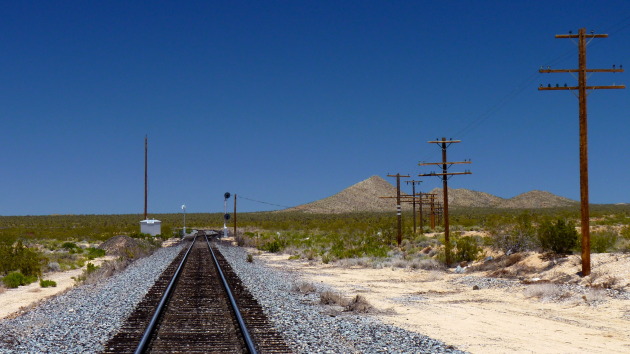 CP Chase - UP trackage at Chase, CA in the Mojave National Preserve. [5/29/2010 - Cima Subdivision]
CP Chase - UP trackage at Chase, CA in the Mojave National Preserve. [5/29/2010 - Cima Subdivision]
As the temperature rose, I realized that I had been on the road for nearly 12 hours at this point and I began to feel weary. As I sat at the crossing at Cedar Canyon Road, taking a bit of a rest, I looked out the windshield and studied the terrain. Off in the distance, running in a due westerly direction, was a faint line marking an obvious trail of some sort.
After considering my location and my knowledge of the area, I surmised that I was looking at the famous Mojave Road, used by many to access California at the coast. It was initially a route for the local Mohave Indians to hunt and trade along. It wasn’t until after I snapped this photo of the scene that I noticed the marker near the trail-head confirming my discovery (Remember I said I was tired!):
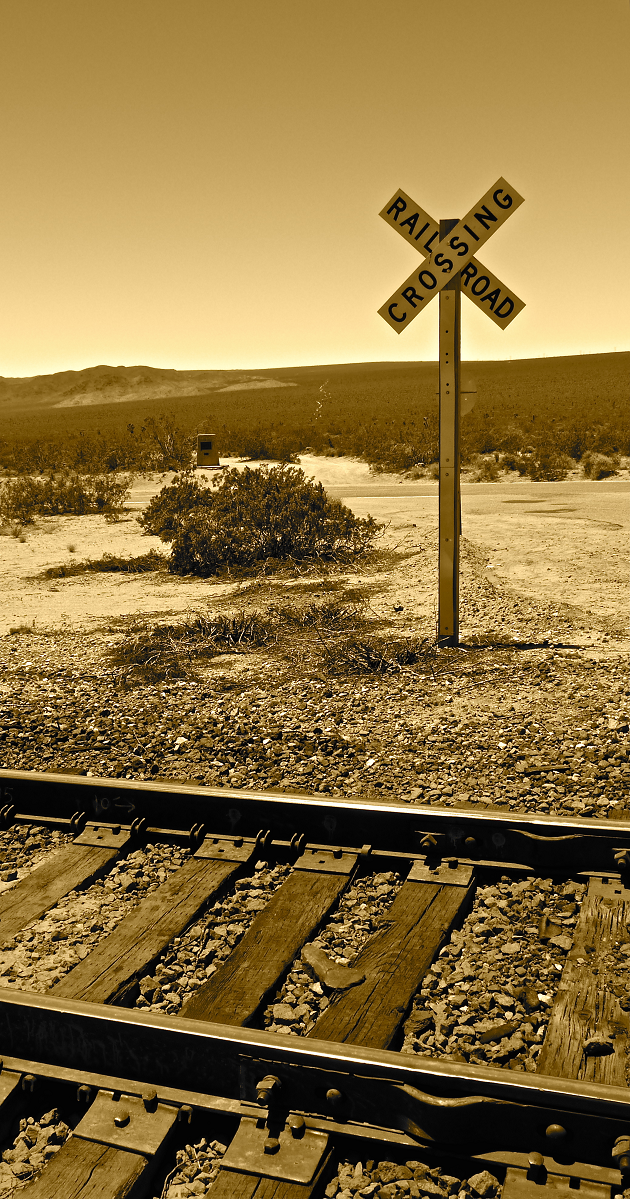 Traveling Through Time - Three arteries of travel, from ancient times through today, comprise this scene in the Mojave National Preserve. In the foreground is Union Pacific’s Cima Subdivision, in the middle of the frame is the Kelso Cima Road and in the distance is the ancient Mojave Road which was used by Mohave Indians to reach the California coast. [5/29/2010 - Cima Subdivision]
Traveling Through Time - Three arteries of travel, from ancient times through today, comprise this scene in the Mojave National Preserve. In the foreground is Union Pacific’s Cima Subdivision, in the middle of the frame is the Kelso Cima Road and in the distance is the ancient Mojave Road which was used by Mohave Indians to reach the California coast. [5/29/2010 - Cima Subdivision]
After waiting nearly an hour I decided it best to try to find a train rather than waiting for one to find me. I bid farwell to CP Chase and raced toward Cima, about 10 miles north on Kelso Cima Road. I made the trek in short order and remembered quickly why I was fond of this area so much.
In my opinion, the area around Cima holds tons of photographic opportunties, with repsect to railroad photography. The are all of the requisite elements of grade, curvature, diversity, and beautiful scenery. The only thing missing, at the time I was there, were the TRAINS!
I began to sense a pattern. I would find a great location to shoot a train from and wait - but no trains would grace the scene for me. I know that the Cima Subdivision has lower traffic volumes than most of the other subdivisions that I chase, but this was down right sad.
I decided to seek out the camp site the ranger had told me about and set-up camp in hopes of a better tomorrow. I departed Cima, and all of the missed opportunites, heading south towards CP Chase. A short distance down the road and I had reached the turnoff for the camp site.
Of of the disadvantages of carrying a “cozy condo” with you, wherever you go, is that your opportunities to turn around are reduced due to the vehicle’s size and weight. So was the case on this road. I had traveled further and further down this road to a point where I began to realize it might take some time to get there and, more importantly, leave there in the cover of darkness tomorrow morning. I had second thoughts about the appropriateness of the “secret camp site” for this particular trip. I looked for a place were I could safely turn around. There was none, as the following photo shows, and I was now committed to the find the camp site:
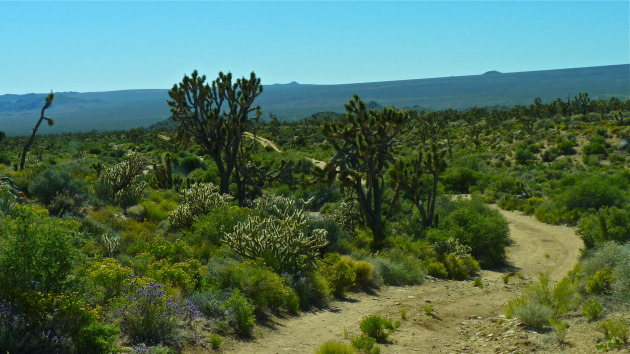 Road to the “Secret Camp Site” - This is the a photograph of the road that led me to the secret camp site described by the ranger. This was the mellowest part of the eight mile trek to the end of the road.
Road to the “Secret Camp Site” - This is the a photograph of the road that led me to the secret camp site described by the ranger. This was the mellowest part of the eight mile trek to the end of the road.
After a good hour’s drive I reached the camp site and could see why the ranger considered it one of the best in the park. The area was beautiful and remained predominately untouched by man. I found myself tucked into a draw, surrounded on three sides by mountains. The area was ablaze with blooming cactus and foliage of all sorts. It was insanely quiet.
I decided to make the most of it since I was here. I parked the truck and got something to eat. After lunch I decided to take a few a “nature” photos since I was miles away from the tracks by now. Here are two of the many shots I took of the local blooms:
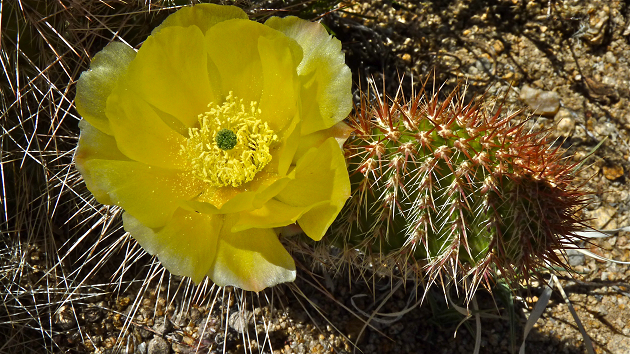 Mohave Pricklypear Cactus Bloom - The beautiful yellow bloom of the Mohave Pricklypear Cactus (Opuntia erinacea).
Mohave Pricklypear Cactus Bloom - The beautiful yellow bloom of the Mohave Pricklypear Cactus (Opuntia erinacea).
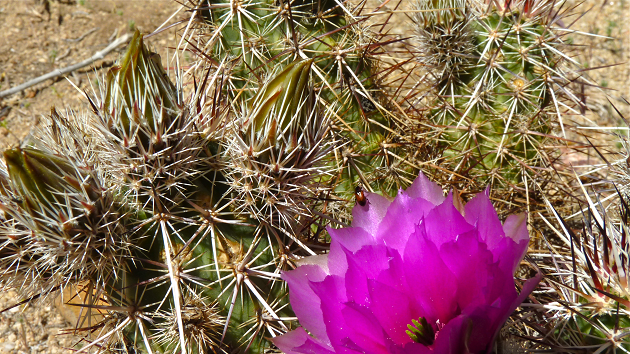 Strawberry Hedgehog Cactus Bloom - A gorgeous Strawberry Hedgehog Cactus flower (Echinocereus engelmannii).
Strawberry Hedgehog Cactus Bloom - A gorgeous Strawberry Hedgehog Cactus flower (Echinocereus engelmannii).
I walked around, being mindful of the ranger’s last words regarding the “abundance” of snakes in the area, and took photos for about one hour when I thought I would rest up a bit in the camper. On my way to camper I saw a previously unseen, large anthill near the camper with the largest black ants I have ever seen! Unfortunately, the ants were heading out in a line straight for my camper! Enough was enough I decided to leave the fun and frivolity of the Mojave National Preserve and the Cima Subdivision behind me…